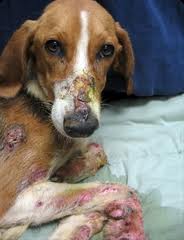Archive ∙ Back to Island Voices
September 2012
There have been several cases of distemper in dogs in the last month. It seems that a litter of puppies brought it up from Mexico. Unfortunately, the disease didn’t become apparent until the dogs arrived in Nanaimo. This means that your dog must be up-to-date on vaccinations.
Distemper is a highly contagious disease caused by a virus similar to the one that causes measles in people. Worldwide, it is the leading cause of infectious disease deaths in dogs, although it occurs only sporadically in our area. All unvaccinated dogs are at high risk of infection.
Infected animals shed canine distemper virus in all body secretions. Inhaling the virus is the primary source of exposure. The highest incidence of the disease occurs in unvaccinated puppies 6 to 12 weeks of age, at which time maternal antibodies fall below protective levels.
Half the dogs who become infected with canine distemper virus show mild signs of illness or no signs at all. The overall health of the dog has a lot to do with how ill he becomes. The disease is most severe in dogs who are poorly nourished and ill-kept.
The distemper virus tends to attack brain cells and cells that line the surfaces of the body, including the skin, the conjunctiva, the mucous membranes of the respiratory tract, and the gastrointestinal tract. The disease takes a variety of forms. Secondary infections and complications are common, partly attributable to the immunosuppressive effects of the virus.
The first signs of distemper appear six to nine days after exposure, and in mild cases go unnoticed. First stage is characterized by a fever spike of up to 103° to 105°F (39.4° to 40.5°C). A second fever spike is accompanied by loss of appetite, listlessness, and a watery discharge from the eyes and nose. These symptoms may be mistaken for a cold.
Within a few days, the eye and nasal discharge becomes thick, yellow, and sticky. The dog develops a pronounced dry cough. Pus blisters may appear on the abdomen. Vomiting and diarrhea are frequent and may cause severe dehydration.
During the next one to two weeks, very often the dog seems to be getting better but then relapses. This often coincides with the end of the course of antibiotics and the development of gastrointestinal and respiratory complications due to secondary bacterial invasion.
Second stage occurs two to three weeks after the onset of the disease. Many dogs develop signs of brain involvement (encephalitis), characterized by brief attacks of slobbering, head shaking, and chewing movements of the jaws (as if the dog were chewing gum). Epileptic-like seizures may occur, in which the dog runs in circles, falls over, and kicks all four feet wildly. After the convulsive episode the dog appears to be confused, shies away from his owner, wanders about aimlessly, and appears to be blind.
In cases with brain involvement in which the diagnosis is uncertain, a spinal tap and analysis of cerebrospinal fluid may be of assistance. But this is not always diagnostic. Another indication of brain involvement is distemper myoclonus, a condition characterized by rhythmic contractions of muscle groups at up to 60 contractions per minute. The jerking can affect all parts of the body, but is most common in the head.
Myoclonus is first seen when the dog is resting or sleeping. Later it occurs both day and night. Pain accompanies myoclonus, and the dog whines and cries. If the dog recovers, the jerking continues indefinitely-but becomes less severe with time.
Hard-pad is a form of distemper in which the virus attacks the skin of the feet and nose, producing thick, horny skin on the nose and callus-like pads on the feet. It first appears about 15 days after the onset of the infection. At one time, hard-pad and encephalitis were thought to be separate diseases, but they are now recognized as being caused by different strains of the distemper virus. Hard-pad is much less common than it was in the past, due to better vaccines and increased use of vaccines.
Treatment: Distemper must be treated by a veterinarian. Antibiotics are used to prevent secondary bacterial infections, even though they have no effect on the distemper virus. Supportive treatment includes intravenous fluids to correct dehydration, medications to prevent vomiting and diarrhea, and anticonvulsants and sedatives to control seizures.
The outcome depends on how quickly you seek professional help, the virulence of the distemper strain, the age of the dog, whether he has been vaccinated, and his ability to mount a rapid and effective immune response to the virus.
Prevention: Vaccination against canine distemper is almost 100 percent protective. All puppies should be vaccinated by 8 weeks of age and have several boosters. We re-vaccinate every five years at our hospital.
**********************************************************************
Web Links
Rare footage of an exam of a dog with distemper:
http://www.youtube.com/watch?v=HyEFS77rOzU
Distemper Disease:
http://www.unbc.ca/nlui/wildlife_diseases_bc/distemper.htm



Leave a Reply